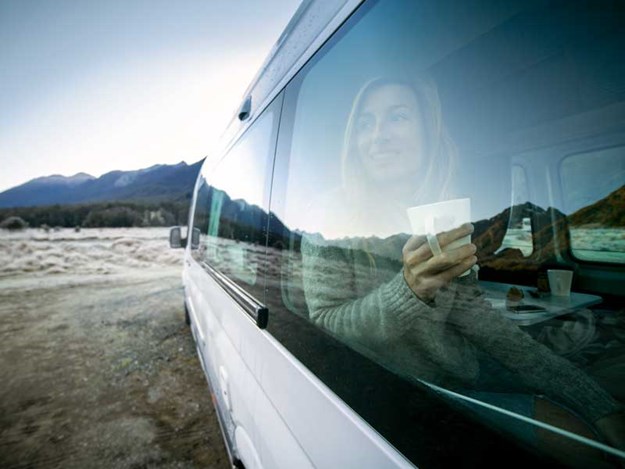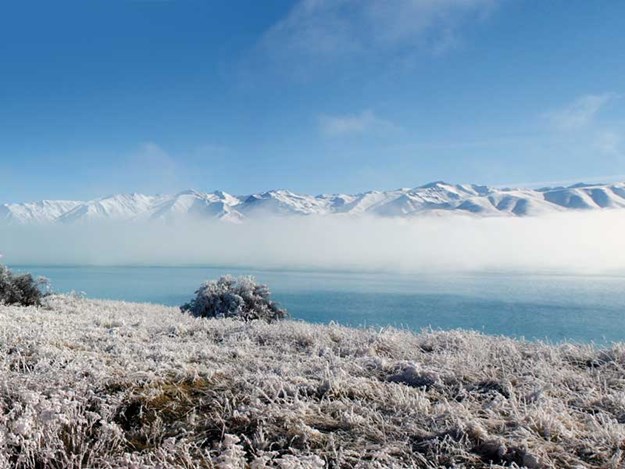Winter has arrived, and it is time to consider your RV plans for the coming months. If you are not going to use your RV until spring or later, here are a few tips that will ensure it is ready to be up and running when you are.

 Give your RV a good wash from top to bottom and then apply a comprehensive coat of wax polish. Check the locks and latches on the windows, doors and hatches to ensure they work correctly. Check that the rubber seals are watertight.
Attend to any leaks before storing the RV. Clean and dry your awning before storing. Caravan electric connection plugs to the car should be cleaned then weather-protected with a plastic bag or wrapping. If you put a cover over your RV, have it checked and repaired where necessary before fitting it for winter.
Give your RV a good wash from top to bottom and then apply a comprehensive coat of wax polish. Check the locks and latches on the windows, doors and hatches to ensure they work correctly. Check that the rubber seals are watertight.
Attend to any leaks before storing the RV. Clean and dry your awning before storing. Caravan electric connection plugs to the car should be cleaned then weather-protected with a plastic bag or wrapping. If you put a cover over your RV, have it checked and repaired where necessary before fitting it for winter.
 In the colder parts of New Zealand frosts can play havoc with RV plumbing. The easiest way to avoid this damage is to remove all water from the plumbing system, including the hot water tank, while the RV is in storage.
Open all the taps in the RV including the shower mixer. Lever taps should be opened and turned mid-way between hot and cold. Next, open the RV’s water system drain valves, both hot and cold, to allow the water to drain.
If you can’t locate these valves, check the RV’s manual or seek advice. Empty out any water remaining in the fresh and grey water tanks. If your fresh water tank doesn’t have a drain valve you may have to pump the water out via the on-board pump through the kitchen sink and the grey water tank.
Driving a short distance with the drains open can facilitate more complete drainage of the system. Don’t forget to remove water filters to prevent water in the filters freezing and causing damage.
If you live in a warm climate where frozen water is not an issue, draining your RV water over winter and starting afresh next season is still a good idea.
In the colder parts of New Zealand frosts can play havoc with RV plumbing. The easiest way to avoid this damage is to remove all water from the plumbing system, including the hot water tank, while the RV is in storage.
Open all the taps in the RV including the shower mixer. Lever taps should be opened and turned mid-way between hot and cold. Next, open the RV’s water system drain valves, both hot and cold, to allow the water to drain.
If you can’t locate these valves, check the RV’s manual or seek advice. Empty out any water remaining in the fresh and grey water tanks. If your fresh water tank doesn’t have a drain valve you may have to pump the water out via the on-board pump through the kitchen sink and the grey water tank.
Driving a short distance with the drains open can facilitate more complete drainage of the system. Don’t forget to remove water filters to prevent water in the filters freezing and causing damage.
If you live in a warm climate where frozen water is not an issue, draining your RV water over winter and starting afresh next season is still a good idea.

Storage
Think about where you plan to keep your RV through winter. It is best stored on a hard surface with good drainage and ventilation underneath, rather than on grass. Avoid trees that may drop sap or branches onto the vehicle. So you can check it monthly, not too far from home is best. Is it a safe location? RV theft, caravans in particular, is on the rise so good security is important. Valuable kit such as TVs, Sky boxes, detachable radios and other portable appliances should be stored out of sight or removed from the RV altogether. If not already fitted, consider installing an intruder alarm.Bodywork
 Give your RV a good wash from top to bottom and then apply a comprehensive coat of wax polish. Check the locks and latches on the windows, doors and hatches to ensure they work correctly. Check that the rubber seals are watertight.
Attend to any leaks before storing the RV. Clean and dry your awning before storing. Caravan electric connection plugs to the car should be cleaned then weather-protected with a plastic bag or wrapping. If you put a cover over your RV, have it checked and repaired where necessary before fitting it for winter.
Give your RV a good wash from top to bottom and then apply a comprehensive coat of wax polish. Check the locks and latches on the windows, doors and hatches to ensure they work correctly. Check that the rubber seals are watertight.
Attend to any leaks before storing the RV. Clean and dry your awning before storing. Caravan electric connection plugs to the car should be cleaned then weather-protected with a plastic bag or wrapping. If you put a cover over your RV, have it checked and repaired where necessary before fitting it for winter.
Tyres
Some braking systems are reluctant to release after being ‘on’ for a long time, so store your RV with the handbrake off if you can, and chock the wheels instead. Caravan owners should lower the corner steadies and rest them on blocks. During your monthly inspections move the RV wheels a quarter of a turn to minimise the risk of getting flat spots on the tyres. If you cannot move the RV, instead jack up the wheels and rotate them by hand.LPG
In most instances LPG bottles are best left in the vehicle’s dedicated locker unless the RV is stored in a building. Remember, LPG on the loose flows and ponds like water. Do not store LPG bottles in your house, car or garage; store them outside, making sure that if LPG leaks out it cannot flow into buildings or drains. If the bottles are left on board, turn the bottle valve and the RV internal valve to ‘off’.Batteries
If the 12-volt house battery is not needed aboard during the winter, for example to run an alarm system, consider removing it to a cool, dry place where its charge levels can be checked from time to time and restored when necessary. Otherwise use mains or solar power to keep the battery charged via the RV house battery charger. It is a good time to remove batteries from TV remotes, smoke and gas detectors to be replaced with new ones next spring.Interior
Give the RV interior, inside all the drawers, lockers and cupboards, a thorough clean before tucking it up for winter. It is okay to leave tinned and bottled food and beverages aboard but best to remove the rest. Leaving blinds and/or insect screens lowered does provide privacy, security and UV protection over the winter months; however, it reduces the life of the springs that retract them. If it is practical to do so, store cushions in a warm, dry place at home. Because RV cushions are expensive to replace, an RV without cushions is less likely to be stolen.Fridge
Empty the fridge and wash it out with a solution of two tablespoons of baking soda in a litre of warm water. Rinse with a damp cloth, then dry with a clean towel. Leave the doors to both the fridge and freezer box ajar so that air can circulate.Ventilation
Allow the RV to breathe during winter storage. Leave vents uncovered and windows and hatches slightly open in ‘breathe mode’ wherever possible so the air can circulate. Opening all drawers, doors and hatches, including the oven and the space beneath it, make it easier for air to circulate. Soft furnishings and cushions will benefit from this air circulation if they are moved away from the RV walls. Crystal dehumidifier packs can be effective in quiet corners prone to mould. Fitting covers over the vents for the fridge and the air intakes for the gas and water heaters can stop ants or cockroaches moving into your RV while it is hibernating. The heater vent covers are usually original equipment supplied with the RV when new. The fridge vent covers are available from RV supply shops. Tape a note to the steering wheel as a reminder to remove the vent covers at the start of the next season. Visit your RV regularly to check the interior is dry and mould-free.Toilet
Clean the toilet cassette locker and clean the cassette both inside and out. Should you need it, there are toilet cleaners that deal with calcium build-up. Apply ‘seal lube’ or olive oil to the rubber ring on the top opening so the slide blade opens and closes correctly. Leave the blade in the open position while the RV is stored.Water system
 In the colder parts of New Zealand frosts can play havoc with RV plumbing. The easiest way to avoid this damage is to remove all water from the plumbing system, including the hot water tank, while the RV is in storage.
Open all the taps in the RV including the shower mixer. Lever taps should be opened and turned mid-way between hot and cold. Next, open the RV’s water system drain valves, both hot and cold, to allow the water to drain.
If you can’t locate these valves, check the RV’s manual or seek advice. Empty out any water remaining in the fresh and grey water tanks. If your fresh water tank doesn’t have a drain valve you may have to pump the water out via the on-board pump through the kitchen sink and the grey water tank.
Driving a short distance with the drains open can facilitate more complete drainage of the system. Don’t forget to remove water filters to prevent water in the filters freezing and causing damage.
If you live in a warm climate where frozen water is not an issue, draining your RV water over winter and starting afresh next season is still a good idea.
In the colder parts of New Zealand frosts can play havoc with RV plumbing. The easiest way to avoid this damage is to remove all water from the plumbing system, including the hot water tank, while the RV is in storage.
Open all the taps in the RV including the shower mixer. Lever taps should be opened and turned mid-way between hot and cold. Next, open the RV’s water system drain valves, both hot and cold, to allow the water to drain.
If you can’t locate these valves, check the RV’s manual or seek advice. Empty out any water remaining in the fresh and grey water tanks. If your fresh water tank doesn’t have a drain valve you may have to pump the water out via the on-board pump through the kitchen sink and the grey water tank.
Driving a short distance with the drains open can facilitate more complete drainage of the system. Don’t forget to remove water filters to prevent water in the filters freezing and causing damage.
If you live in a warm climate where frozen water is not an issue, draining your RV water over winter and starting afresh next season is still a good idea.





